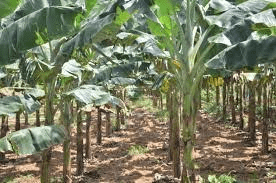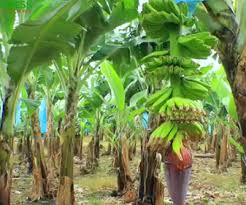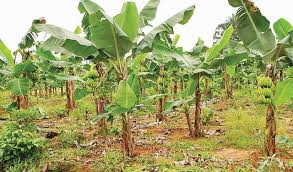The recommended spacing is 3 m between the plantain rows and 2 m within the row (in other words. 3 m x 2 m). An alternative is 2.5 m x 2.5 m. If spaced 3 m x 2 m, 1 hectare should contain 1667 plants, but with a spacing of 2.5 m x 2.5 m, it should contain 1600 plants.
Rows should be straight in flat fields to give plants the maximum amount of sunlight. However, on sloping land, rows should follow the contour lines in order to decrease soil erosion.
Plantain plant care requires well-draining soil, regular watering and protection from wind or frost. It is recommended for you to choose a sunny, warm area of your garden and dig a hole that is as deep as the root ball.
Below is a comprehensive step by step guide on how to grow and care for plantains / bananas:
While not the same as bananas, plantains do look quite similar. However, they have a firmer, less sugary fruit, and they are generally cooked rather than eaten fresh. Although both the banana tree and the plantain tree are members of the Musa genus. They are technically large herbs, and their fruit is classified as berries. The starchy plantain is generally treated as more of a potato, though, and it can be boiled or mashed, or eaten with salt.

Both plantains, as well as their cultivated ancestors, originated on the Malaysian peninsula, New Guinea, and Southeast Asia. They are a hybrid of two species of banana: Musa acuminata and Musa balbisiana.
Climbing up to 12 to 15 feet tall, the plantain tree is known for ornamental beauty, even without the fruit. Its giant leaves wrap around its trunk and its purple bud-like flowers are produced from the pseudostem and develop into a cluster of hanging fruit.
Read Also: Ways of Preparing Plantain Suckers for Planting
This tree isn’t necessarily the easiest to grow. It will require at least 10 to 15 months, assuming it hasn’t been subjected to freezing temperatures, in order to produce flowers. Plus, an additional four to eight months is needed to actually grow plantains.
Botanical Name
Musa paradisiaca
Common Name
Plantain tree
Plant Type
Herbaceous perennial
Mature Size
12-15 feet
Sun Exposure
Full sun
Soil Type
Moist, well-drained
Soil pH
5.5-6.5
Bloom Time
Summer
Flower Color
Purple bud
Hardiness Zones
8-11, USA
Native Area
Southeast Asia, Malaysia, New Guinea
Plantain Tree Care Guide

According to a recent detailed research, below are the ideal methods of caring for a plantain or banana tree:
Plantain trees are grown just like bananas and will require well-drained soil, frequent watering, and protection from both the wind and frost. When first planting a plantain tree, you’ll want to be sure to remove any weeds that might be growing from the soil, and try to aim for the warmest, sunniest section of your landscape. Be sure to use a shovel to dig a hole that’s as big as the root ball, and space the tree about four to six feet away from any other plants in the garden.
(1) Light
The plantain tree will grow best in full sun. When planting, if you can take advantage of any reflected heat that might be radiating off paved areas or nearby buildings, that’s even better.
(2) Water
Plantain trees will require constantly moist, but not waterlogged, soil. As a result, these trees will require a fairly large amount of water during the warmest months of the year. Try to water the soil whenever the top layer begins to dry out.
(3) Soil
One of the most important rules of plantain tree care is not to let them dry out, these are trees that crave moist soil as well as regular watering, particularly during hot, dry weather.
Try spreading a four-to-six-inch layer of organic mulch around the base of the tree. Mulching can help keep the soil from drying out too quickly, as well as protect the plantain tree’s shallow roots.
(4) Temperature and Humidity
The plantain tree is a tropical tree plant that cannot withstand freezing temperatures, the cold will kill off its fruit, flowers, and leaves. As a result, you may have to take extra steps to protect your tree when the cold weather arrives. This could include the use of blankets and light bulbs (you can even use a string of holiday lights) when the temperatures dip below freezing.
The good news, however, is that the plantain tree’s rhizomes will survive in the ground at temperatures down to 22 degrees Fahrenheit. So, if your tree does die off above the ground, the rhizome will send up new shoots come spring.
(5) Fertilizer

Since this is a tropical plant that feeds heavily, you’ll want to fertilize your plantain tree about once a month during the summer. Mature trees will require about one to two pounds of fertilizer. Opt for a balanced 8-10-8, slow-release fertilizer.
Spread the granulated fertilizer in a circle about four-to-eight-feet wide around the base of the plant, and then scratch it into the top inch of soil with a hand cultivator. Try not to sprinkle fertilizer on the trunk.
Read Also: The Different Plantain Planting Materials
Propagating Plantain Trees
When propagating a new plantain plant, you can leave just one sucker on the plant at a time. Let it grow on the parent plant for about six to eight months before removing it, and then start the new plant in a container until it’s large enough to be transplanted outdoors.
Pruning
You can prune away most of the tree’s suckers with a pair of pruners. These young plantain plants will extract nutrients and moisture from the parent plant.
Read Also: TV Recycling Process Complete Guide
Frequently Asked Questions
We will update this section soon.

